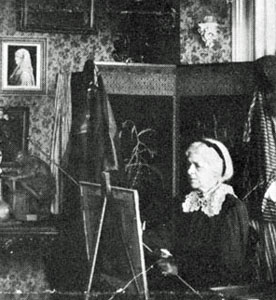Charlotte Schreiber facts for kids
Quick facts for kids
Charlotte Schreiber
|
|
|---|---|

Charlotte M.B. Schreiber, working in her studio at Erindale, Ontario, 1895
|
|
| Born |
Charlotte Mount Brock Morrell
21 May 1834 Woodham Mortimer, Essex, United Kingdom
|
| Died | 3 July 1922 (aged 88) |
| Nationality | British-Canadian |
| Known for | Painting |
| Spouse(s) | Weymouth George Schreiber |

Charlotte Mount Brock Schreiber RCA (born May 21, 1834, died July 3, 1922) was an amazing artist. She was an English-Canadian painter and illustrator. She was also one of the first important female painters in Canada.
Contents
Early Life and Art Training
Charlotte Schreiber, whose maiden name was Morrell, was born in Essex, England. She became a successful artist in England before moving to Canada in 1875.
She studied at Mr. Carey's School of Art in London. There, she learned from John Rogers Herbert, a famous artist known for historical paintings and portraits. Charlotte also studied how the human body works. She loved painting people and nature, saying it was a "joy to paint them as they are in reality."
With her training, Charlotte became a professional artist early on. She showed her art at the Royal Academy when she was just 21. She also got jobs to draw pictures for several books. In 1875, she married her cousin, Weymouth Schreiber. She moved to Toronto, Canada, with him and his three children.
Becoming a Canadian Artist
Charlotte quickly became involved in the art world in Toronto. In 1876, just one year after she arrived, she joined the Ontario Society of Artists. The next year, she became the first woman to teach at the Ontario School of Art. This school is known today as OCAD University. She was also the only woman on the school's council.
Charlotte also helped start the Women's Art Association of Canada. This group supported female artists.
First Woman in the Royal Canadian Academy
In 1880, Charlotte Schreiber made history. She became the first woman ever elected to the Royal Canadian Academy of Arts. Before her, only men were allowed to join this important group.
Even though this was a huge step, she could not attend meetings or help make decisions. For 53 years, Charlotte was the only woman in the academy. The next woman, Marion Long, was not elected until 1933.
Her Famous Painting: The Croppy Boy
The National Gallery of Canada owns a special painting by Charlotte. She created it for her Academy diploma. It is called The Croppy Boy (The Confession of an Irish Patriot).
This painting tells a sad story from an old Irish song. The song is about a young man who goes to a church to confess his sins. He is getting ready for a battle during the Irish rebellion of the 1790s. But the person he thinks is a priest is actually a British soldier in disguise. The soldier arrests him, and he is taken away.
Charlotte's painting shows the young man kneeling, talking seriously to the cloaked soldier. The viewer can see the soldier's uniform, but the young man cannot. Both figures have red in their clothes. The soldier is in the shadows, while the youth is in the light. This might show Charlotte's feelings about the story.
Charlotte's Artistic Style
Charlotte Schreiber made huge contributions to Canadian art. She painted scenes from everyday life. She often based her paintings on things she saw and people she knew.
For example, her 1876 painting Don`t Be Afraid shows children playing in the snow. She watched them closely on the banks of the Credit River. Charlotte was very committed to showing things as they truly were. Because of this, she is known for bringing the realist style of art to Canada.
Her experience in England also helped bring new European art styles to Canada. This helped Canadian art grow and become more mature. Charlotte's work showed the realist movement. It combined ideas from both neoclassicism and romanticism. You can see this in her Portrait of Edith Quinn. It looks very natural, like a story, but also shows great detail.
Inspired by Books
Literature also influenced Charlotte's art. Early in her career, she drew pictures for poems by famous writers. These included Geoffrey Chaucer, Edmund Spenser (for The Faerie Queene), and Elizabeth Barrett Browning.
Later Years
After a long and successful career in Canada, Charlotte Schreiber moved back to England in 1898. This was after her husband passed away. She died in Paignton, South Devon, England, in 1922.
See also
 In Spanish: Charlotte Schreiber para niños
In Spanish: Charlotte Schreiber para niños

